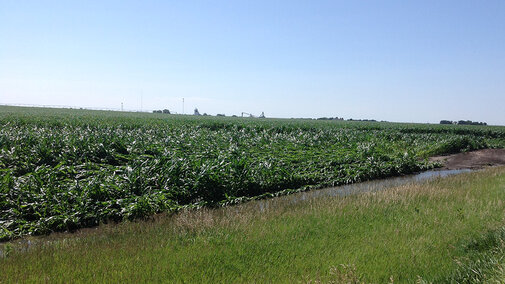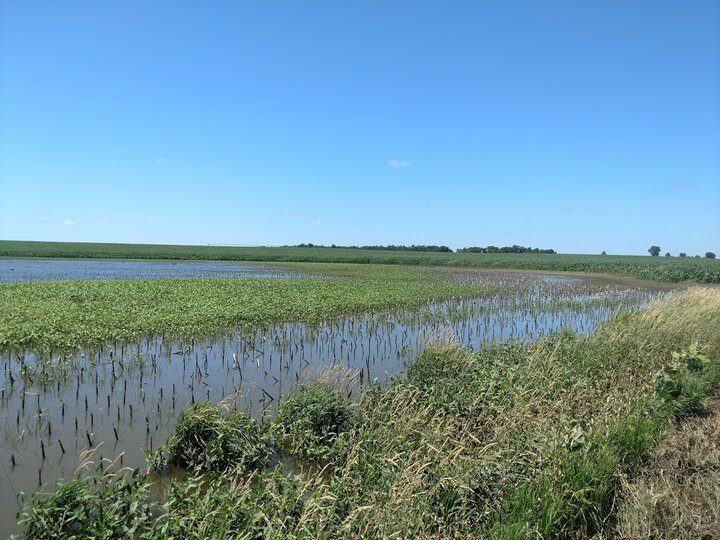
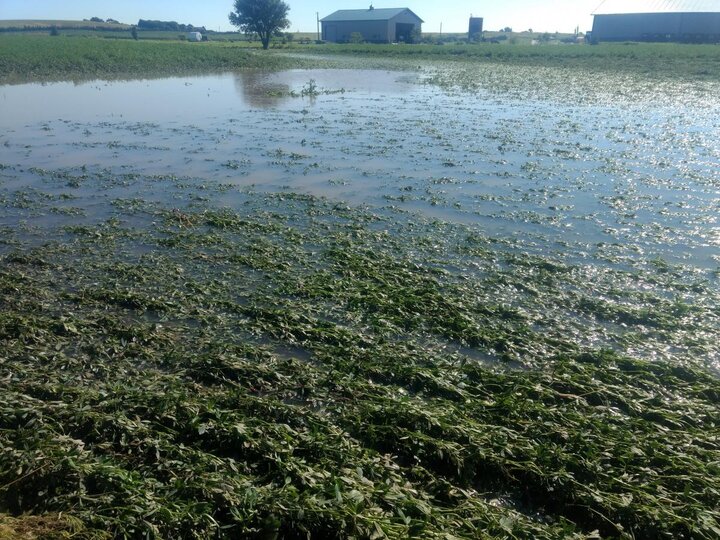
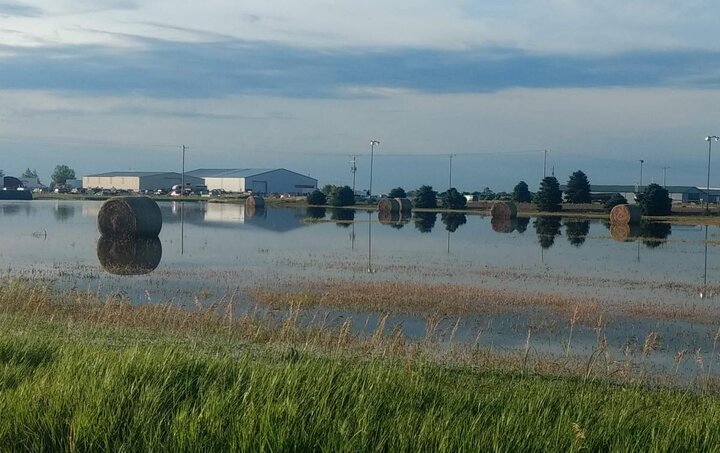
Randy Pryor, Extension Educator, Saline County: Wheat harvest began in the fields planted the end of September. Weather permitting, combines will be going by the weekend. The yield outlook is optimistic. The straw market is strong. Many producers will sell the straw and plant a cover crop rather than chemical fallow. With the rain this past week and light rain Monday night, it will continue to carry our corn crop into R1 without running pivots except for fertigation which is rare. Rainfall has exceeded ET in corn every week until this last week in many locations. Soybeans planted the third week in May have struggled in certain fields compared to soybeans planted earlier between spring rainfall events. (7/9/19)
Tyler Williams, Extension Educator, Lancaster County: We had 0.25 inches of rain Monday night, but the area is dry. I have yet to see crop stress, but it probably isn't far away with the warmer and drier pattern on the way. Corn is V12 to flag leaf and is growing fast. It looks pretty good for most of the area. Soybeans are V6 to flowering. Waterhemp seems to be the weed on the rise right now. We got through the wave of thistle caterpillar issues, but another wave is likely on the way. (7/9/19)
Sarah Sivits, Extension Educator in Dawson, Buffalo, and Hall Counties: We're wet, very wet. We should start seeing tassels in the next week or two in some fields, while other fields are way behind. We're seeing common rust, Holcus spot, and bacterial leaf streak, but have not seen gray leaf spot yet. Some soybeans are flowering and some others are cupping, likely due to off-site herbicide drift. In soybean we've had thistle caterpillars and a consultant has reported Japanese beetles near Cozad. One western bean cutworm egg mass was found near North Platte. We haven't seen much progress with the second cutting of hay. (7/9/19)
Nathan Mueller, Extension Educator in Dodge and Washington Counties: Southeast Nebraska wheat growers have started harvest, but those north of the Platte have yet to start. This season has been a challenge from one extreme to another. Northern Dodge and northern Washington counties are fairly dry and some corn was curling Monday. The southern halves of the counties have seen more rain and crops are in better condition. Some V6 corn is not as deeply rooted as taller corn. Corn and soybean growth stages are quite variable, with soybean from V3-V4 to flowering and corn from V6 to over your head. Alfalfa is on its second cutting. (7/9/19)
John Wilson, Extension Educator in Burt County: Southern Burt County is really dry, while the northern part has caught rain (2-5 inches, depending on location) and is doing better. We need a timely rain. As in many other counties, crop growth stage is quite variable, depending on planting date. Soybean growth is from the 4th trifoliate up to flowering. (7/9/19)
Steve Melvin, Extension Educator in Merrick and Hamilton Counties: There are a lot of prevented planting acres in Merrick County, while in Hamilton County, planting went well and corn fields are uniform and look good. Some hay has been cut but a lot of hay meadows sitll have water. Availability of cover crop seed is limited and one of the most common questions I'm getting is "What kind of cover crop will work with the NRCS guidelines?" (7/9/19)
Megan Taylor, Extension Educator in Platte, Boone and Nance Counties: Soybean gall midge has been confirmed in Nance County. Bacterial leaf streak and holcus spot are in corn and this morning I found gray leaf spot north of Platte Center. (7/9/19)
Melissa Bartels, Extension Educator in Butler and Polk Counties: Soybean gall midge has now been found in Butler County. Corn and soybean growth stages are varied across the county, with some corn nearing V12-V13. We're seeing common rust, Holcus spot, and bacterial leaf streak in corn. (7/9/19)
Michael Sindelar, Extension Educator in Clay County: We’ve gotten almost too much rain for this time of the year and in places the corn is leaning in saturated soils, likely due to low rooting depths and recent high windstorms. We're seeing common rust and bacterial leaf streak in corn. (7/9/19)
Chuck Burr, Crops and Water Extension Educator at the West Central Research and Extension Center, North Platte: Corn is growing out of some early-season nutrient deficiencies and is looking a lot better. Quite a bit of hay was cut the week before last when conditions were drier. We've got about 2.5 inches of rain in the last few days. (7/9/19)
Karen DeBoer, Extension Educator in Cheyenne County: We’ve had some consistent rains over the last week totaling about 2 inches. We’re still seeing some green in wheat and are probably 1-1.5 weeks away from starting wheat harvest. There's some lodging, likely due to high winds and saturated soils from recent storms. The wheat looks good though and we’re expecting good yields. Corn and all other crops are way behind. Peas look good. (7/9/19)
Todd Whitney, Extension Educator in Phelps County: We’re experiencing the monsoon season with 4-5 inches of rain last week and 5 inches last night. Nearby areas got 7 inches. All four nearby counties are flooding. Soils are completely saturated and we hope this system moves out soon. We were about ready to start wheat harvest when the rains set in. (7/9/19)
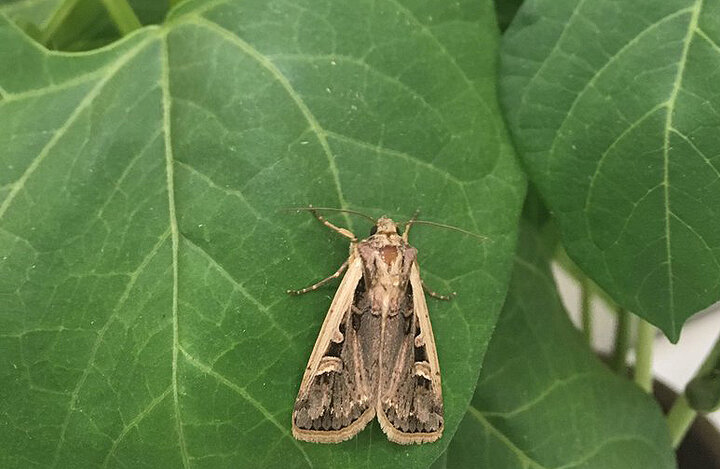
Julie Peterson, Extension Entomologist, WCREC, North Platte: The first western bean cutworm were caught at North Platte on July 3. Find trap information, reported daily all through the WBC flight, at https://entomology.unl.edu/agroecosystems/black-light-trap-data. For additional information on this pest see Western Bean Cutworm Central. Plenty of thistle caterpillar reports in soybean are still coming in, but most are close to pupating or have already pupated from this first generation. It seems like the second generation will need to be closely watched and could overlap with the decreased defoliation threshold period during soybean pod fill. I have received several inquiries about identifying the sand chafer versus the rose chafer versus the Japanese beetle, as this seems to be the emergence peak for those scarabs. We saw some emerged Dectes stem borer adults in soybean at North Platte this past week. (They have also been reported emerging in north central Kansas.) First generation European corn borer damage has occurred in non-Bt plots at the WCREC, but likely was not enough to warrant an insecticide application. (7/8/19)
Jeff Bradshaw, Extension Entomologist, Panhandle REC, Scottsbluff: We collected our first western bean cutworm July 8 just nine miles north of Scottsbluff by blacklight. (7/8/19)
